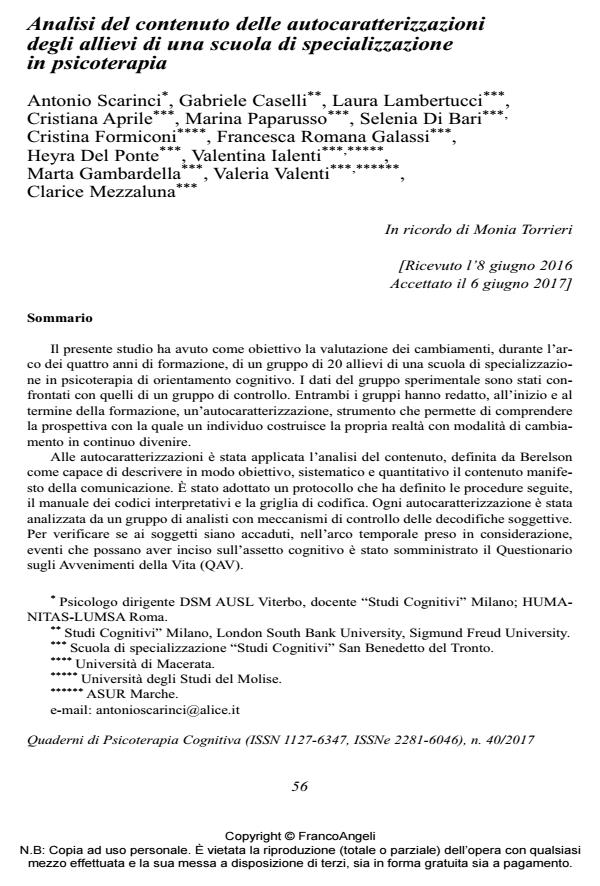Content analysis of self-characterizations of students from a postgraduate psychotherapy school
Journal title QUADERNI DI PSICOTERAPIA COGNITIVA
Author/s Antonio Scarinci, Gabriele Caselli, Laura Lambertucci, Cristiana Aprile, Marina Paparusso, Selenia Di Bari, Cristina Formiconi, Francesca Romana Galassi, Heyra Del Ponte, Valentina Ialenti, Marta Gambardella, Valeria Valenti, Clarice Mezzaluna
Publishing Year 2017 Issue 2017/40 Language Italian
Pages 21 P. 56-76 File size 207 KB
DOI 10.3280/QPC2017-040004
DOI is like a bar code for intellectual property: to have more infomation
click here
Below, you can see the article first page
If you want to buy this article in PDF format, you can do it, following the instructions to buy download credits

FrancoAngeli is member of Publishers International Linking Association, Inc (PILA), a not-for-profit association which run the CrossRef service enabling links to and from online scholarly content.
The present study was aimed at evaluating changes, during the span of four-years training, in a group of twenty students from a postgraduate cognitive psychotherapy school. The data of the experimental group were compared with those of a control group. Both groups have drawn up, at the beginning and at the end of the training course, self-characterization, tool that allows us to understand the perspective from which an individual builds his/her own reality through constantly evolving change modes. Content analysis was applied to self-characterizations, as defined by Berelson as something able to describe the manifest content of communication in an objective, systematic and quantitative way. It was adopted a protocol that defines the procedures followed, the manual of interpretation codes and the encoding grid. Each self-characterization has been analyzed by a group of analysts with control mechanisms of the subjective decoding. Life Events Questionnaire (QAV) was admnistered to test whether subjects have undergone, in time period taken into consideration, events affecting their own cognitive set-up. The research results attest to significant variations between the experimental group and control group. The students, after four years of training, believe that others recognize in them a greater ability to explain behavior and attitudes of others, more self-reflective ability, a sense of satisfaction at the completion of their training and then taking a professional role.
Keywords: Self-characterization, training in psychotherapy, content analysis, cognitivebehavioural psychotherapy, accommodation.
- Bennett-Levy J., Thwaites R. (2009). Il sé e l’autoriflessività nella relazione terapeutica. In: Gilbert P., Leahy R.L. (eds.), La relazione terapeutica in terapia cognitivo-comportamentale. Firenze: Eclipsi.
- Biondi M., Palma A., Pancheri P. (1993). Questionario Avvenimenti della Vita (QAV) e Guida all’Intervista Strutturata sugli Avvenimenti della Vita (GISAV) per il rilevamento degli avvenimenti stressanti. Rivista di Psichiatria, 28: 179-188.
- Biondi M., Pancheri P. (1988). Eventi stressanti e malattia: nuovi metodi di analisi quantitativa. In: Biondi M. (a cura di), Aggiornamenti in medicina psicosomatica. Roma: Società Editrice Universo.
- Buckner R.L., Carroll D.C. (2007). Self-projection and the brain. Trends in Cognitive Sciences, 11(2): 49-57.
- Byrd R.K., Patterson L., Turchik J.A. (2010). Working alliance as a mediator of client attachment dimension and psychotherapy outcome. Psychotherapy, 47: 631-637.
- Castonguay L., Hill C.E. (eds.) (2007). Insight in psychotherapy. Washington DC: American Psychological Association.
- Faraci S. et al. (2000). Autocaratterizzazione e diagnosi: Indagine qualitativa della struttura. Psicoterapia, 6, 21: 13-18.
- Fasola C., Lattanzi S. (2008). Il pensiero di George Herbert Mead. Retrieved October 5, 2013, --testo disponibile al sito: http://www.scienzepostmoderne.org/DiversiAutori/Mead/PensieroMead.html, data consultazione: 01.02.2013.
- Fleccher P.C., Happè F., Frith U., Baker S.C., Dolan R.J., Frackowiak R.S. et al. (1995). Other minds in the brain: A functional imaging study of “theory of mind” in story comprehension. Cognition, 57(2): 109-128. DOI: 10.1016/0010-0277(95)00692-
- Fabbro N., Bazzoli M., Ciaghi M., Colucci V., Dalla Bona E., Dalla Valle M. et al. (2013). Esplorare la mente di psicoterapeuti in formazione: Qualità del parenting, stile di attaccamento, capacità di discriminazione delle emozioni e ruolo degli eventi di vita in un campione di specializzandi. Cognitivismo Clinico, 10, 1: 65-86.
- Framba R. (2008). L’autocaratterizzazione. In: Incerti A., Scarinci A. (a cura di), Assessment dei disturbi d’ansia. Trento: Erickson, pp. 127-160.
- Hill C.E. (2014). Helping skills: Facilitating exploration, insight and action (4th ed.). Washington DC: American Psychological Association.
- Hill C.E., O’Brien K. (1999). Helping skills: Facilitating exploration, insight and action. Washington DC: American Psychological Association.
- James W. (2004). Principi di psicologia. Milano: Principato Editore.
- Kelly G. (1955). The psychology of personal constructs. New York: W.W. Norton.
- Liotti G., Monticelli F. (2008). I sistemi motivazionali nel dialogo clinico: Il manuale AIMIT. Milano: Raffaello Cortina.
- Losito G. (1996). L’analisi del contenuto nella ricerca sociale. Milano: FrancoAngeli.
- Mancini F., Santoruvo A., Biondani I., Battilana E., Carolo M., Carrozzo E. et al. (2013). La percezione di autoefficacia negli psicoterapeuti in formazione: Un’indagine esplorativa. Cognitismo Clinico, 10(2): 173-184.
- Maslow A. H. (1973). Motivazione e personalità. Roma: Astrolabio.
- Neisser U. (1981). Conoscenza e realtà. Bologna: Il Mulino.
- Orlinsky D.E., Ronnestad M.H. (eds.) (2005). How Psychotherapist Develop: A study of Therapeutic Work and Professional Grown.Washington DC: American Psychological Association
- Palmonari A., Cavazza N., Rubini M. (2002). Psicologia sociale. Bologna: Il Mulino.
- Piñuel Raigada J.L. (2002). Epistemología, metodología y técnicas del análisis de contenido. Estudios de Sociolingüística, 3(1): 1-42.
- Semerari A. (1999). Psicoterapia cognitiva del paziente grave: Metacognizione e relazione terapeutica. Milano: Raffaello Cortina.
- Spreng R.N., Mar R.A., Kim A.S. (2009).The common neural basis of autobiographical memory, prospection, navigation, theory of mind, and the default mode: A quantitative meta-analysis. Journal of Cognitive Neuroscience, 21(3): 489-510.
Antonio Scarinci, Gabriele Caselli, Laura Lambertucci, Cristiana Aprile, Marina Paparusso, Selenia Di Bari, Cristina Formiconi, Francesca Romana Galassi, Heyra Del Ponte, Valentina Ialenti, Marta Gambardella, Valeria Valenti, Clarice Mezzaluna, Analisi del contenuto delle autocaratterizzazioni degli allievi di una scuola di specializzazione in psicoterapia in "QUADERNI DI PSICOTERAPIA COGNITIVA" 40/2017, pp 56-76, DOI: 10.3280/QPC2017-040004